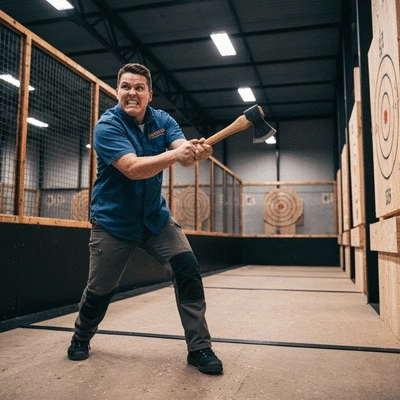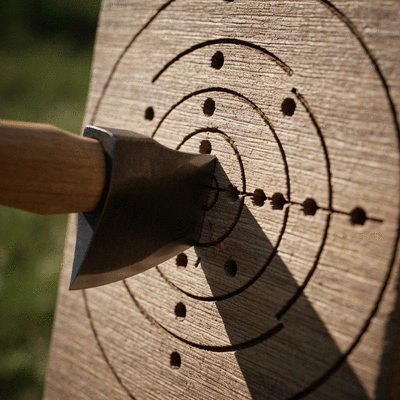World Axe Throwing League (WATL)
Focuses on:
- • Standardized rules across venues
- • Emphasis on rules and scoring
- • Promotes friendly competition
Welcome to Axe Throwing Guide – your ultimate resource for all things axe throwing in Australia!
Oct 27
Axe throwing is not just a sport; it's a vibrant community experience that brings people together. With its rising popularity and structured competitions, understanding the dynamics of these events can significantly enhance your enjoyment and participation.
This visual highlights the distinctions between the two major axe throwing leagues, the World Axe Throwing League (WATL) and the International Axe Throwing Federation (IATF), focusing on their primary characteristics and philosophies. For those new to the sport, our beginner's guide to axe throwing offers a great starting point to understand the basics before diving into competitive play.
Focuses on:
Offers:
Axe throwing competitions are more than just a test of skill; they’re also a celebration of community and camaraderie. Participants gather to showcase their talent, compete for glory, and connect with fellow enthusiasts. Whether you’re an experienced thrower or just starting your journey, understanding the dynamics of these competitions can greatly enhance your experience.
So, what exactly are axe throwing competitions? These events typically involve participants throwing axes at a target, with the objective of scoring points based on accuracy and skill. Competitions can vary widely in format, from casual local events to more structured leagues that follow specific rules and regulations.
Axe throwing competitions are organized events where participants throw axes at a wooden target, aiming to hit the bullseye for maximum points. These competitions can take place in various formats, such as:
This blend of structure and social interaction is what makes competitions so appealing! At Axe Throwing Guide, we love to see both new throwers and seasoned veterans enjoying the thrill of competition. If you're looking to take your game to the next level, check out our axe throwing competition prep guide.
In recent years, axe throwing has exploded in popularity, leading to the formation of organized leagues. The two major leagues, the World Axe Throwing League (WATL) and the International Axe Throwing Federation (IATF), have different rules and formats, catering to various styles of play and competition. Understanding their differences is crucial for any aspiring competitor:
Each league has its own unique flavor, so exploring both can help you find the right fit for your competitive spirit!
The roots of axe throwing as a sport can be traced back to its origins as a practical skill for survival. However, its evolution into a recreational activity has gained momentum over the last few decades. The sport has transformed from a rural pastime into a vibrant community event, celebrated across Australia and beyond.
Today, axe throwing is recognized not just as a sport, but also as a way to bring people together and foster a sense of community. As Jacklyn Ames, the founder of Axe Throwing Guide, often says, "Every throw is a chance to connect, learn, and grow." This spirit of connection is what makes the competitions so worthwhile.
To improve your axe throwing accuracy, focus on your grip and stance. Hold the axe like a handshake—firm but relaxed—and ensure your feet are shoulder-width apart. Practice your throw with a smooth motion, visualizing the bullseye with each release. Small adjustments can make a big difference in your performance!
Before stepping into the thrilling world of axe throwing competitions, it’s crucial to understand the rules that govern these events. These guidelines not only help maintain fair play but also ensure everyone's safety while enjoying the sport. Let's delve into the essential rules and structures that every competitor should be aware of!
Axe throwing competitions have specific rules that all participants must follow to create a level playing field. Here are some key regulations you should keep in mind:
Understanding these rules is vital for a smooth competition experience. Remember, following the guidelines helps everyone enjoy the sport without issues!
Competitions can be categorized into two primary formats: individual and team events. Each format brings a unique experience and set of challenges:
Choosing the right format can shape your competition experience, so consider what fits your style best!
Knowing the specific throwing distances and axe specifications is essential for competitors. Here's a quick overview:
Be sure to check the league's rules regarding equipment specifications. It’s all about having the right tools to succeed!
Understanding the scoring system is pivotal for any competitor. Here's how points are generally awarded:
By familiarizing yourself with the scoring, you can strategize your throws for maximum points!
The two major axe throwing leagues are the World Axe Throwing League (WATL) and the International Axe Throwing Federation (IATF). They differ in their rules and approach, with WATL focusing on standardization and IATF offering more flexibility for venues.
Axe throwing competitions typically come in individual competitions, where throwers compete solo; team events, where groups work together for a collective score; and league play, which involves regular matches over an extended period.
Key safety rules include wearing closed-toe shoes, maintaining a clear throwing area, following specific lane protocols, and safely retrieving axes by the handle. Adhering to these rules ensures the safety of all participants.
Points are generally awarded based on the target zones hit, with the bullseye offering the highest score. Missed throws typically result in zero points, making accuracy crucial for success.
Most leagues enforce a throwing distance that ranges from 12 to 15 feet, though this can vary slightly depending on the specific league or competition format.
As exciting as axe throwing is, safety should always come first. Understanding the safety guidelines will not only protect you but also your fellow competitors.
Wearing the right safety equipment and attire is a fundamental aspect of competing safely in axe throwing. Here’s what you need:
By prioritizing safety gear, you can focus on your throws without worrying about potential injuries. For more detailed information on essential safety equipment, refer to our guide on axe throwing safety gear essentials.
Safety in the throwing area is a shared responsibility. Here are some vital protocols to follow:
By adhering to these protocols, you help create a secure and enjoyable environment for everyone involved!
Retrieving your axe can be risky if not done correctly. Here's how to do it safely:
Following these retrieval procedures can help minimize injuries and keep the competition running smoothly.
Competitors should always be aware of their physical limitations. If you have any medical conditions, consider the following:
Being mindful of your health ensures you can enjoy axe throwing to the fullest!
In case of an emergency, knowing the procedures can save lives. Remember to:
Being prepared for emergencies allows you to focus on your performance without unnecessary worry.
In axe throwing, good sportsmanship is just as important as skill. Understanding how to conduct yourself in a competitive environment is crucial for fostering a positive community.
Every competitor should be familiar with the code of conduct, which promotes respect and fairness. Here’s what it typically includes:
Adhering to these principles ensures a friendly environment that encourages everyone to grow and improve!
Disputes may arise during competitions, but it's essential to handle them professionally. Here's how:
Respecting officials not only upholds the integrity of the competition but also sets a great example for others.
Here is a quick recap of the important points discussed in the article:
Axe Throwing Enthusiast. Founder of Axe Throwing Guide. Inspiring the thrill of the throw.
Jacklyn Ames is dedicated to transforming beginners into confident axe throwers, providing expert insights and safety tips, empowering enthusiasts across Australia to embrace a thrilling, social activity. Join her on our blog for daily tips and tailored strategies that simplify your axe throwing journey and enhance your skills.
Avid Axe Throwing Enthusiast. Founder of Axe Throwing Guide. Inspiring the thrill of the throw.
Jacklyn Ames is dedicated to transforming novices into confident throwers and fostering a vibrant community, empowering axe throwing enthusiasts across Australia to embrace a thrilling and engaging social experience. Join her on our blog for expert insights and tailored strategies that simplify your axe throwing journey and enhance your recreational well-being.


